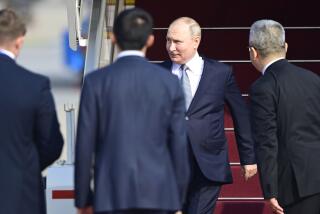Business-Savvy Hungarians Try to Make Chinese Feel at Home
- Share via
BUDAPEST, Hungary — Crimson Chinese lanterns hang from the fluorescent lights in the classrooms, and a little Chinese flag perches on the principal’s desk. Gym is taught by a Chinese champion in the martial art of wushu, and the students skittering through the hallways are as likely to greet you with a “Ni hao” as a “Jo napot.”
Hungary’s first public elementary school geared toward Chinese students opened its doors this month, an unprecedented effort by the Chinese and Hungarian governments to provide for Central Europe’s largest Chinese enclave.
Budapest’s thriving Chinese community has not always been appreciated. But the Hungarian government, keen to build on relations with an economically ascendant China, is trying to make these residents feel at home.
“This school is good because the Chinese can stay Chinese while they become accustomed to Hungarian habits,” said first-grade teacher Marta Laszlo.
Housed in an unassuming building in a Budapest suburb, the Hungarian-Chinese Bilingual Primary School, which covers grades 1 through 4, has nearly 100 students.
In addition to the normal Hungarian curriculum taught in that language, there is instruction in Mandarin, with separate classes for native speakers and those who are learning Chinese. Students study Chinese art and music and can take math in Chinese. Tai chi is taught on the indoor basketball court.
About 90% of the students are Chinese nationals, and most of the others are part of Hungarian-Chinese families. Richard Zhang, who is 9, has a Chinese father and a Hungarian mother. “He is here to learn Chinese because his father forgot to teach him,” said his mother, Krisztina. “It’s important that he can communicate with the other side of the family.”
Just weeks into the school year, the teachers still grapple with instructing students of widely varying language abilities. A few, such as Richard, speak no Chinese. The older children, who have attended local public schools, are often more comfortable with Hungarian than Chinese.
Some speak other Chinese dialects at home and are being exposed to Mandarin for the first time. All of the students struggle with the written Chinese language. Many children, however, already appear comfortable in their new bilingual environment, rapidly switching between Hungarian and Chinese.
One 10-year-old introduced himself as Simone, saying, “It’s an Italian name, but I have a Chinese name too.” Huang Jing Yi was born in Florence, Italy, and moved to Budapest when he was 4. “But I’ve forgotten Italian,” the fourth-grader said.
There are 12 Hungarian and eight Chinese teachers, but only a few are fluent in both languages. The principal, Peter Vigh, speaks only Hungarian. “Sometimes the students have to interpret for us,” he said.
The Chinese presence in Hungary is a fairly recent development. Thousands migrated to the country after 1988, when the then-communist government in Hungary instituted visa-free travel for Chinese nationals. Visas were reimposed in 1992.
Official figures put the current number of Chinese at 12,000, but unofficial estimates are at least twice as high. The nation as a whole has a population of a little more than 10 million.
The new school represents the first time the Chinese government has been involved in a Chinese school overseas, said Gabor Nagy, head of international relations at the Hungarian Ministry of Education.
There are other bilingual schools in the Hungarian capital, but this one is the only public facility intended for expatriates. Many from the U.S., for example, send their children to the private American International School here.
Nagy, whose wife is Chinese and whose 7-year-old son will take classes at the public school, said the facility enables the Chinese in Hungary and children of mixed parentage to celebrate their “double identity.”
“It would be a pity if these Chinese children would completely forget their Chinese identity and culture,” he said. “It would be a mistake to totally assimilate them.”
Hungary has not always shown interest in accommodating its Chinese population, said Pal Nyiri, a Hungarian anthropologist who has focused on the Chinese in Eastern Europe.
“There is a widespread idea that there are too many Chinese, and they are not seen as part of Hungarian society,” he said.
The European Values Study, a poll in 32 European countries taken by the Netherlands’ Tilberg University, found that Hungary was among the least tolerant of foreigners. More than 60% of Hungarians surveyed said they did not want immigrants or foreign workers as neighbors.
For many Hungarians, interaction with the Chinese community is limited to commerce. The majority of Chinese residents are involved in trade, and the outdoor Chinese market in central Budapest is known among shoppers as the place to go for cheap, Chinese-made clothing and household appliances.
Now Hungary, which joined the European Union in May, hopes to become a gateway for Chinese business flowing into Europe. Nyiri calls the Chinese school an “astute gesture to attract investment.”
Just a few blocks away is the new Asia Center, a vast complex built -- according to feng shui principles -- to showcase Chinese and other Asian goods.
Soon the Chinese community’s medical needs will also be attended to -- next year a state-run hospital in Budapest will open a department of traditional Chinese medicine, to be staffed by Chinese doctors.
There may be another reason for the Chinese and the Hungarians to feel an affinity beyond business ties. “There is a theory that the Hungarians originally came from northern China,” Nagy said.
More to Read
Sign up for Essential California
The most important California stories and recommendations in your inbox every morning.
You may occasionally receive promotional content from the Los Angeles Times.










